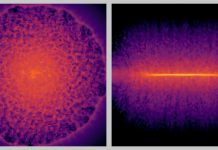
Solving big, complicated problems—like planning work shifts, finding the best traffic routes, or developing new drugs—can take traditional computers an extremely long time.
That’s why researchers have been developing a special type of hardware called annealing processors (APs) that can tackle these tough tasks much more efficiently.
APs work using a model called the Ising model, where problems are turned into tiny magnetic spins, and solving the problem is like finding the lowest energy state of the system.
There are two kinds of Ising models: sparsely-coupled, which can handle lots of spins but needs extra steps to fit the problems into the model, and fully-coupled, which can solve problems directly but has limits in size and accuracy.
Until now, fully-coupled APs struggled because they couldn’t easily expand both their size (how many spins they can handle) and their precision (how detailed the problem interactions can be).
But a research team from Japan, led by Professor Takayuki Kawahara from the Tokyo University of Science, has made a major breakthrough.
They have developed a new system called the Dual Scalable Annealing Processing System (DSAPS), which can grow both capacity and precision at the same time.
Their study was published in IEEE Access and presented at the 2024 International Conference on Microelectronics.
The DSAPS system cleverly controls blocks that calculate the system’s energy. It uses two approaches: one to divide and handle more spins, and another to improve precision by layering calculations at different bit levels and combining them.
In simple terms, it’s like building a bigger and more detailed puzzle without changing the way the pieces fit together.
To show that DSAPS works, the researchers built two versions. One could manage 2,048 spins with medium-level precision, and the other could manage 1,024 spins with extremely high precision. In tests, both versions solved standard problems with impressive accuracy, with the high-precision version performing nearly as well as top-level CPU simulations.
This advancement is important because it allows APs to be better tailored to different kinds of real-world problems, depending on whether more size or more precision is needed.
Professor Kawahara says that starting in 2025, DSAPS technology will even be used in student experiments at the university to teach the next generation of engineers. The study marks a big step toward creating powerful, flexible machines that can solve complex optimization problems in everything from business planning to scientific research.



